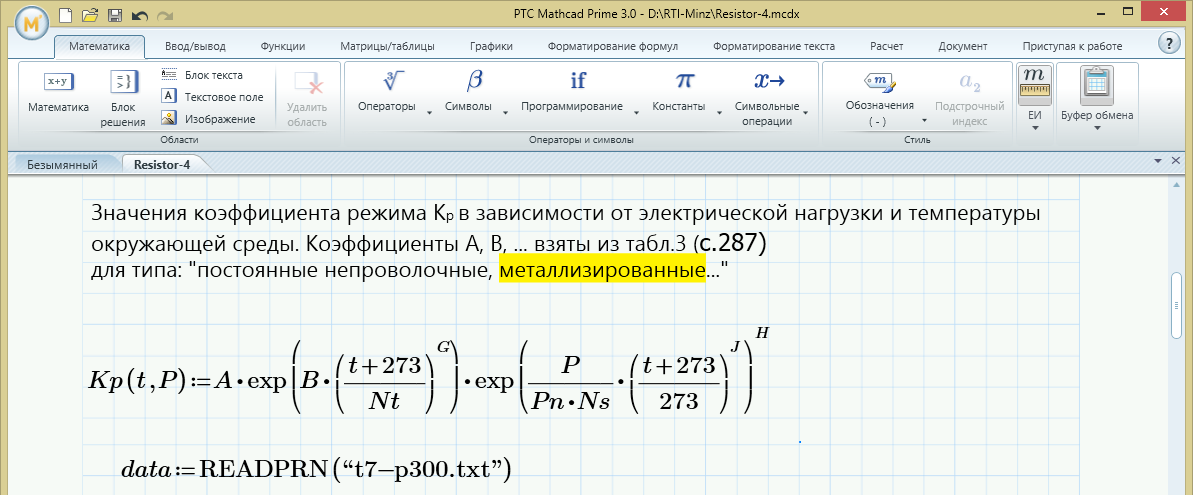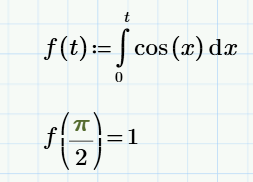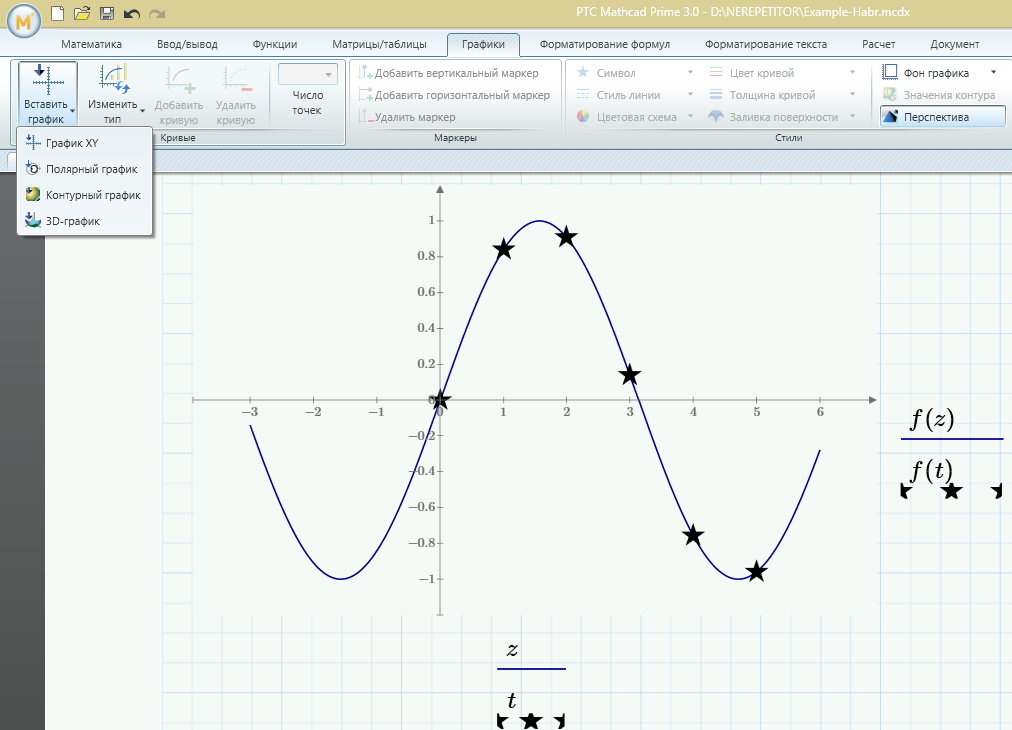Mathcad Express is a free math editor that few people know about.
- Tutorial
First of all, I welcome the first visitors to my blog. This is my first article on Habré and I hope that I can tell you a lot of useful things here.
RTS Mathcad is a typical example of mathematical software designed for both numerical and analytical calculations using formulas and visualizing their results in the form of graphs. Over the past years, Mathcad has become very popular, and in my opinion, it can rightfully be considered the No. 1 mathematical package in the world.
First, a few facts about Mathcad, of course, known to most readers, because We have been using Mathcad for more than a dozen years in university education, scientific and engineering calculations. Most likely, you used the "old" version of Mathcad (the last - at number 15), which has not changed much since the last century. Today, it coexists quite successfully with the younger Mathcad family, which bears the name Mathcad Prime. Thus, several years ago, the developers completely rewrote the program code, but did not begin to worry about 100% compatibility. Therefore, now they are safely supporting both families - the “old” Mathcad and the “new” Mathcad Prime. Further in this article, and in my blog, we will talk specifically about Mathcad Prime.

I must say right away that you can download the Russian -language distribution kit, a fully functional 30-day version of Mathcad Prime from the website of the Russian RTS reseller . If you are already going to try it in work, my advice is not to rush in the Installation Wizard to agree to the inclusion of a 30-day test period. The fact is that Mathcad Prime, along with a powerful full-featured version (the window of which you see above) has a free limited version called Mathcad Express. A feature of Mathcad Express is that most of the functions in this version are turned off and are not available. Nevertheless, the Mathcad Express program remains quite rich in functionality, sufficient, at least, to study mathematics at school and in the 1st year of a technical university.

Formulas can be entered into documents either from the keyboard (if there are suitable characters on it), or using the Mathematics menu . For the sake of example, let's calculate the integral of the function cos (x). To do this, select the symbol of the integral, and then - in the appropriate placeholders we enter (from the keyboard) the integration limits and the integrand function cos (x). It remains to press the equal key to immediately receive an answer.

We need to have a good idea of what happens when we introduce the equal sign. Namely, the corresponding numerical algorithm for calculating the integral is launched: the integration interval is divided into a number of segments, at certain points of which an array of values of the integrand is calculated, which is then converted into the corresponding approximation of the integral sum. Thus, most of the calculations are hidden and occur “behind the scenes”, and only the final result is displayed on the screen.
Key Mathcad tools are operators and functions. For example, in our calculations, we used the integration operator and the cosine function. It is convenient to use the Functions menu to select the desired built-in function .
Let's now define a user-defined function f (t), which will depend on the variable t. We will use the assignment operator intended for this in Mathcad (the colon with an equal sign).

We defined the function f (t) as our integral of cos (x) with a variable upper limit t. After we have defined the function f (t), we can calculate its values in points (for which it is enough to enter the argument and press the “equal” key to display the answer in the document). To enter a constant, such as π, use either the Symbols menu or the Constants menu .
As an argument, you can use not only a scalar, but also a vector variable. It can be defined as follows:

Then the corresponding vector will be the result of calculating the function.
Finally, one of the important features of Mathcad Express is the ability to plot in a document. Let's select a place in the document and insert in this place the XY-graph (i.e., the Cartesian graph) of our function f (x).
We denote the name of the variable z on the abscissa axis (so as not to be confused with the previously used x and t), and on the ordinate axis we denote the name of the function f (z), a function that, as you recall, we defined as the integral of the cosine, which is equal of course , sin (z). As a result, we get a graph of this function.

I will also say that in Mathcad Express (possibly due to a developer oversight) matrix operations remain available. Therefore, Mathcad Express is a fairly powerful tool for solving linear algebra problems.

Moving up and down the document, we can view our calculations, and you can manage them using the menuCalculation . By default, the option of automatic calculation is enabled (as you enter the formulas in the document, these formulas are immediately calculated). If you disable this option, then in order to calculate the document manually, just click the Calculate button .

Let me stop at this, believing that the task of acquainting the reader with Mathcad Express has been solved, and in the next blog articles, when it comes to mathematics, I can use the calculations in Mathcad without delving into its interface.
In conclusion, I am addressing the interested reader to my video course on mathematical analysis , which was held in the MEP format on the INTUIT portal in 2014. All laboratory work has been done at Mathcad Prime and can be downloaded here.. All these materials on the Nerepetitor.ru website are free, registration is not required.
PS. To my surprise, when I came across several negative comments, I note several shortcomings of Mathcad (again, from my point of view):
RTS Mathcad is a typical example of mathematical software designed for both numerical and analytical calculations using formulas and visualizing their results in the form of graphs. Over the past years, Mathcad has become very popular, and in my opinion, it can rightfully be considered the No. 1 mathematical package in the world.
First, a few facts about Mathcad, of course, known to most readers, because We have been using Mathcad for more than a dozen years in university education, scientific and engineering calculations. Most likely, you used the "old" version of Mathcad (the last - at number 15), which has not changed much since the last century. Today, it coexists quite successfully with the younger Mathcad family, which bears the name Mathcad Prime. Thus, several years ago, the developers completely rewrote the program code, but did not begin to worry about 100% compatibility. Therefore, now they are safely supporting both families - the “old” Mathcad and the “new” Mathcad Prime. Further in this article, and in my blog, we will talk specifically about Mathcad Prime.

I must say right away that you can download the Russian -language distribution kit, a fully functional 30-day version of Mathcad Prime from the website of the Russian RTS reseller . If you are already going to try it in work, my advice is not to rush in the Installation Wizard to agree to the inclusion of a 30-day test period. The fact is that Mathcad Prime, along with a powerful full-featured version (the window of which you see above) has a free limited version called Mathcad Express. A feature of Mathcad Express is that most of the functions in this version are turned off and are not available. Nevertheless, the Mathcad Express program remains quite rich in functionality, sufficient, at least, to study mathematics at school and in the 1st year of a technical university.

Formulas can be entered into documents either from the keyboard (if there are suitable characters on it), or using the Mathematics menu . For the sake of example, let's calculate the integral of the function cos (x). To do this, select the symbol of the integral, and then - in the appropriate placeholders we enter (from the keyboard) the integration limits and the integrand function cos (x). It remains to press the equal key to immediately receive an answer.

We need to have a good idea of what happens when we introduce the equal sign. Namely, the corresponding numerical algorithm for calculating the integral is launched: the integration interval is divided into a number of segments, at certain points of which an array of values of the integrand is calculated, which is then converted into the corresponding approximation of the integral sum. Thus, most of the calculations are hidden and occur “behind the scenes”, and only the final result is displayed on the screen.
Key Mathcad tools are operators and functions. For example, in our calculations, we used the integration operator and the cosine function. It is convenient to use the Functions menu to select the desired built-in function .
Let's now define a user-defined function f (t), which will depend on the variable t. We will use the assignment operator intended for this in Mathcad (the colon with an equal sign).

We defined the function f (t) as our integral of cos (x) with a variable upper limit t. After we have defined the function f (t), we can calculate its values in points (for which it is enough to enter the argument and press the “equal” key to display the answer in the document). To enter a constant, such as π, use either the Symbols menu or the Constants menu .
As an argument, you can use not only a scalar, but also a vector variable. It can be defined as follows:

Then the corresponding vector will be the result of calculating the function.
Finally, one of the important features of Mathcad Express is the ability to plot in a document. Let's select a place in the document and insert in this place the XY-graph (i.e., the Cartesian graph) of our function f (x).
We denote the name of the variable z on the abscissa axis (so as not to be confused with the previously used x and t), and on the ordinate axis we denote the name of the function f (z), a function that, as you recall, we defined as the integral of the cosine, which is equal of course , sin (z). As a result, we get a graph of this function.

I will also say that in Mathcad Express (possibly due to a developer oversight) matrix operations remain available. Therefore, Mathcad Express is a fairly powerful tool for solving linear algebra problems.

Moving up and down the document, we can view our calculations, and you can manage them using the menuCalculation . By default, the option of automatic calculation is enabled (as you enter the formulas in the document, these formulas are immediately calculated). If you disable this option, then in order to calculate the document manually, just click the Calculate button .

Let me stop at this, believing that the task of acquainting the reader with Mathcad Express has been solved, and in the next blog articles, when it comes to mathematics, I can use the calculations in Mathcad without delving into its interface.
In conclusion, I am addressing the interested reader to my video course on mathematical analysis , which was held in the MEP format on the INTUIT portal in 2014. All laboratory work has been done at Mathcad Prime and can be downloaded here.. All these materials on the Nerepetitor.ru website are free, registration is not required.
PS. To my surprise, when I came across several negative comments, I note several shortcomings of Mathcad (again, from my point of view):
- there is only a windows version
- resource-intensive, running slower than the "past" Mathcad
- the interface could be more convenient
- You cannot save a document in a previous version (e.g. from the 3rd in the 2nd format)
- Mathcad past documents cannot always be imported into Prime
